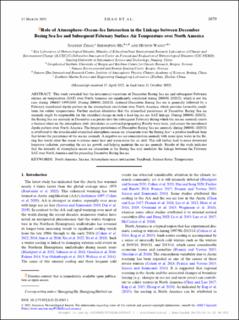Role of Atmosphere-ocean-ice Interaction in the Linkage between December Bering Sea Ice and Subsequent February Surface Air Temperature Over North America
Journal article, Peer reviewed
Published version

Åpne
Permanent lenke
https://hdl.handle.net/11250/3064929Utgivelsesdato
2023Metadata
Vis full innførselSamlinger
- Geophysical Institute [1198]
- Registrations from Cristin [9791]
Originalversjon
Journal of Climate. 2023, 36 (6), 1679–1696. https://doi.org/10.1175/JCLI-D-22-0265.1Sammendrag
This study revealed that the interannual variations of December Bering Sea ice and subsequent February surface air temperature (SAT) over North America are significantly correlated during 2000/01-2020/21, which is not the case during 1966/67-1999/2000. During 2000/01-2020/21, reduced December Bering Sea ice is generally followed by a February meridional dipole pattern in the atmospheric circulation over North America, which provides favorable conditions for colder temperatures. Further analysis elucidates that the intensified persistence of December Bering Sea ice anomaly might be responsible for the identified change in such a lead-lag sea ice-SAT linkage. During 2000/01-2020/21, the Bering Sea ice anomaly in December can persist into the subsequent February during which the Bering Sea ice anomaly can stimulate an eastward-propagating Rossby wave train propagating to North America and causing the meridional dipole pattern. The longer persistence of December Bering Sea ice anomaly during 2000/01-2020/21 is attributed to the interdecadal intensified atmosphere-ocean-ice interaction over the Bering Sea - a positive feedback loop that favors the persistence of Bering Sea ice anomaly. A negative sea-ice concentration anomaly with more open water in the Bering Sea would allow the ocean to release more heat and warm more the air aloft. This will lead to more downward longwave radiation, preventing the winter sea ice growth and helping maintain the Bering Sea ice anomaly. Results of this study indicates that the intensity of atmosphere-ocean-ice interaction in the Bering Sea may modulate the linkage between the February SAT over North America and the preceding December Bering Sea ice.